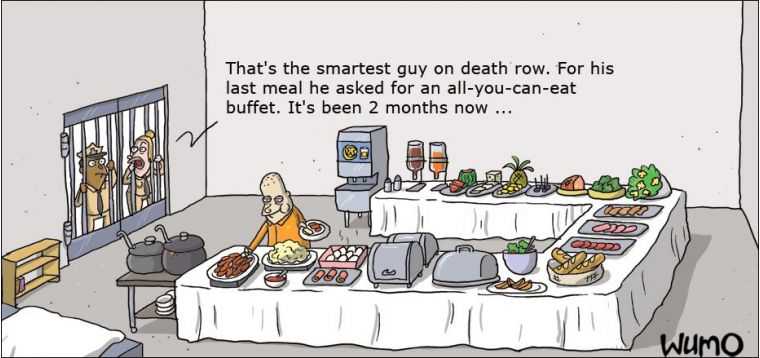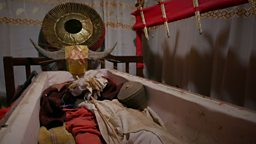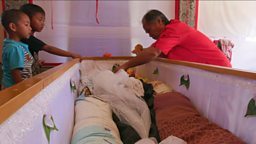The Economist cover story April 29 2017 :
End-of-life care How to have a better death
Death is inevitable. A bad death is not

IN
1662 a London haberdasher with an eye for numbers published the first
quantitative account of death. John Graunt tallied causes such as “the
King’s Evil”, a tubercular disease believed to be cured by the monarch’s
touch. Others seem uncanny, even poetic. In 1632, 15 Londoners “made
away themselves”, 11 died of “grief” and a pair fell to “lethargy”.
Graunt’s book is a glimpse of the suddenness and terror of death before modern medicine. It came early, too: until the 20th century the average human lived about as long as a chimpanzee. Today science and economic growth mean that no land mammal lives longer. Yet an unintended consequence has been to turn dying into a medical experience.
How,
when and where death happens has changed over the past century. As late
as 1990 half of deaths worldwide were caused by chronic diseases; in
2015 the share was two-thirds. Most deaths in rich countries follow
years of uneven deterioration. Roughly two-thirds happen in a hospital
or nursing home. They often come after a crescendo of desperate
treatment. Nearly a third of Americans who die after 65 will have spent
time in an intensive-care unit in their final three months of life.
Almost a fifth undergo surgery in their last month.
Such zealous intervention can be agonising for all concerned (see article). Cancer patients who die in hospital typically experience more pain, stress and depression than similar patients who die in a hospice or at home. Their families are more likely to argue with doctors and each other, to suffer from post-traumatic stress disorder and to feel prolonged grief.
Some deaths are unavoidably miserable. Not everyone will be in a condition to toast death’s imminence with champagne, as Anton Chekhov did. What people say they will want while they are well may change as the end nears (one reason why doctors are sceptical about the instructions set out in “living wills”). Dying at home is less appealing if all the medical kit is at the hospital. A treatment that is unbearable in the imagination can seem like the lesser of two evils when the alternative is death. Some patients will want to fight until all hope is lost.
But too often patients receive drastic treatment in spite of their dying wishes—by default, when doctors do “everything possible”, as they have been trained to, without talking through people’s preferences or ensuring that the prognosis is clearly understood. Just a third of American patients with terminal cancer are asked about their goals at the end of life, for example whether they wish to attend a special event, such as a grandchild’s wedding, even if that means leaving hospital and risking an earlier death. In many other countries, the share is even lower. Most oncologists, who see a lot of dying patients, say that they have never been taught how to talk to them.
This newspaper has called for the legalisation of doctor-assisted dying, so that mentally fit, terminally ill patients can be helped to end their lives if that is their wish. But the right to die is just one part of better care at the end of life. The evidence suggests that most people want this option, but that few would, in the end, choose to exercise it. To give people the death they say they want, medicine should take some simple steps.
More palliative care is needed. This neglected branch of medicine deals with the relief of pain and other symptoms, such as breathlessness, as well as counselling for the terminally ill. Until recently it was often dismissed as barely medicine at all: mere tea and sympathy when all hope has gone. Even in Britain, where the hospice movement began, access to palliative care is patchy. Recent studies have shown how wrongheaded that is. Providing it earlier in the course of advanced cancer alongside the usual treatments turns out not only to reduce suffering, but to prolong life, too.
Most doctors enter medicine to help people delay death, not to talk about its inevitability. But talk they must. A good start would be the wider use of the “Serious Illness Conversation Guide” drawn up by Atul Gawande, a surgeon and author. It is a short questionnaire designed to find out what terminally ill patients know about their condition and to understand what their goals are as the end nears. Early research suggests it encourages more, earlier conversations and reduces suffering.
These changes should be part of a broad shift in the way health-care systems deal with serious illness. Much care for the chronically ill needs to move out of hospitals altogether. That would mean some health-care funding being diverted to social support. The financial incentives for doctors and hospitals need to change, too. They are typically paid by insurers and governments to do things to patients, not to try to prevent disease or to make patients comfortable. Medicare, America’s public health scheme for the over-65s, has recently started paying doctors for in-depth conversations with terminally ill patients; other national health-care systems, and insurers, should follow. Cost is not an obstacle, since informed, engaged patients will be less likely to want pointless procedures. Fewer doctors may be sued, as poor communication is a common theme in malpractice claims.
Graunt’s book is a glimpse of the suddenness and terror of death before modern medicine. It came early, too: until the 20th century the average human lived about as long as a chimpanzee. Today science and economic growth mean that no land mammal lives longer. Yet an unintended consequence has been to turn dying into a medical experience.
Such zealous intervention can be agonising for all concerned (see article). Cancer patients who die in hospital typically experience more pain, stress and depression than similar patients who die in a hospice or at home. Their families are more likely to argue with doctors and each other, to suffer from post-traumatic stress disorder and to feel prolonged grief.
What matters
Most important,
these medicalised deaths do not seem to be what people want. Polls,
including one carried out in four large countries by the Kaiser Family
Foundation, an American think-tank, and The Economist,
find that most people in good health hope that, when the time comes,
they will die at home. And few, when asked about their hopes for their
final days, say that their priority is to live as long as possible.
Rather, they want to die free from pain, at peace, and surrounded by
loved ones for whom they are not a burden.Some deaths are unavoidably miserable. Not everyone will be in a condition to toast death’s imminence with champagne, as Anton Chekhov did. What people say they will want while they are well may change as the end nears (one reason why doctors are sceptical about the instructions set out in “living wills”). Dying at home is less appealing if all the medical kit is at the hospital. A treatment that is unbearable in the imagination can seem like the lesser of two evils when the alternative is death. Some patients will want to fight until all hope is lost.
But too often patients receive drastic treatment in spite of their dying wishes—by default, when doctors do “everything possible”, as they have been trained to, without talking through people’s preferences or ensuring that the prognosis is clearly understood. Just a third of American patients with terminal cancer are asked about their goals at the end of life, for example whether they wish to attend a special event, such as a grandchild’s wedding, even if that means leaving hospital and risking an earlier death. In many other countries, the share is even lower. Most oncologists, who see a lot of dying patients, say that they have never been taught how to talk to them.
This newspaper has called for the legalisation of doctor-assisted dying, so that mentally fit, terminally ill patients can be helped to end their lives if that is their wish. But the right to die is just one part of better care at the end of life. The evidence suggests that most people want this option, but that few would, in the end, choose to exercise it. To give people the death they say they want, medicine should take some simple steps.
More palliative care is needed. This neglected branch of medicine deals with the relief of pain and other symptoms, such as breathlessness, as well as counselling for the terminally ill. Until recently it was often dismissed as barely medicine at all: mere tea and sympathy when all hope has gone. Even in Britain, where the hospice movement began, access to palliative care is patchy. Recent studies have shown how wrongheaded that is. Providing it earlier in the course of advanced cancer alongside the usual treatments turns out not only to reduce suffering, but to prolong life, too.
Most doctors enter medicine to help people delay death, not to talk about its inevitability. But talk they must. A good start would be the wider use of the “Serious Illness Conversation Guide” drawn up by Atul Gawande, a surgeon and author. It is a short questionnaire designed to find out what terminally ill patients know about their condition and to understand what their goals are as the end nears. Early research suggests it encourages more, earlier conversations and reduces suffering.
These changes should be part of a broad shift in the way health-care systems deal with serious illness. Much care for the chronically ill needs to move out of hospitals altogether. That would mean some health-care funding being diverted to social support. The financial incentives for doctors and hospitals need to change, too. They are typically paid by insurers and governments to do things to patients, not to try to prevent disease or to make patients comfortable. Medicare, America’s public health scheme for the over-65s, has recently started paying doctors for in-depth conversations with terminally ill patients; other national health-care systems, and insurers, should follow. Cost is not an obstacle, since informed, engaged patients will be less likely to want pointless procedures. Fewer doctors may be sued, as poor communication is a common theme in malpractice claims.
One last thing before I go
Most
people feel dread when they contemplate their mortality. As death has
been hidden away in hospitals and nursing homes, it has become less
familiar and harder to talk about. Politicians are scared to bring up
end-of-life care in case they are accused of setting up “death panels”.
But honest and open conversations with the dying should be as much a
part of modern medicine as prescribing drugs or fixing broken bones. A
better death means a better life, right until the end.





Readers' comments
Don't have an account? Register
.
I started having an annual check-up after my husband died*. I did so for 10 years, then I quit while I was ahead. Now, at over 82, I am old enough to die; eventually, we all do so why bother with checkups?
.
[* If you visit a cemetery, you may notice that married people often die within two years of each other. I was sure I was going to die. I did not die after all, and started gardening instead.]
How long should you live, how should you live and finally how and when to die is very personal.
Also, sky burial is an idea whose time has come. Let the vultures and condors feast!
The orders are written, the injection prepared, and the injection given. The dying person falls asleep, so deeply that he/she doesn't wake up for meals, and is sound asleep so never drinks from the glass of water by the bedside.
Unless there is an advocate for that individual, they will die: the advocate works in cooperation with the physicians and nurses to ensure that for the devout Christian believer, the tenets of that faith are respected, for that individual, it must be remembered, this earthly life is but part of life, and the end of life is the time when it is believed that as one life ends, a spiritual journey which we do not understand commences. An Anglican Catholic Priest.
The pope John Paul II° was tracheostomised 7 days before dying by Parkinson disease , setting the standard that it is better to survive miserably than rendering the soul to "God" peacefully ( not a neologism).
My educated guess is they had not made their mind up about his successor jet.
Better suggestions?
.
The right to die in Belgium: An inside look at the world’s most liberal euthanasia law
.
"Belgium has the world’s most liberal law on physician-assisted suicide, which is not just for the terminally ill. Patients with psychiatric conditions – and now, even children – can request euthanasia."
.
MEGAN THOMPSON: As she opens the door to her home…this 34-year old Belgian woman known as “Eva” seems at ease. But actually she’s chronically depressed. More than once she’s tried to commit suicide. And now she’s asking doctors to help her. Help her die by euthanasia…all of it captured in a Belgian documentary.
.
http://www.pbs.org/newshour/bb/right-die-belgium-inside-worlds-liberal-e...
----
I didn't care much for Youth In Asia.
(a British punk band)
.
NSFTL
Regards
The body is a mechanism; incredibly complex to be sure, but sooner or later it will be understood. The reversing of aging in humans *is* going to occur. The only question is whether or not it occurs in our lifetime.
In general, this assertation evokes rejection. I may be wrong, but I think this is because we are all resigned to death, and the proposal - as yet without any real justification - that it might not be so has the effect of bouncing us out of our settled and endurable resignation into a half-way state where we now *might* have the chance of avoiding death - but might not! an uncomfortable position, and one which we most most easily avoid by rejecting the original proposition.
Consider. Imagine I had proposed that mice would eventually be bred who live twice as long. Well, that doesn't cause an emotional reaction, I would say (and in fact, it has been done). Now imagine I might say we would work out how to solve the aging of skin in humans - we all still die at the same time, but at least we dont' wrinkle up :-) that would be remarkable, but again - it does not evoke rejection. Now finally imagine I say that if the solution to skin aging actually solves a whole class of aging in humans, and as a result we will live an extra twenty years - and youthfully - well, now we begin to be closer to my original proposition.
In fact, the body really is just like a car. It is a mechanism, and to use it is to wear it out. Aging is the accumulated damage of use, just as it is in mechanical devices. There is nothing special about figuring out what this damage is and undoing it. We still *age*, but we progressively work out how to *reverse* the accumulation of damage.
What this amounts to of course is the reversal of aging and the restoration of youth. Those who are old, and who carry in their bodies a great deal of accumulated damage, will see that damage reversed, and their bodies "youthen".
Aging in fact basically comes down to about six or seven forms of damage. For example, you accumulate "gunk" in your cells, and between your cells; the body as a byproduct of metabolising generates a range of end-products, and it knows how to get rid of a lot of them - *but not all*. Age-related macular degeneration probably originates in one of these by-products; if you could explain to the body how to get rid of it, the blind would literally see again. A startup in Edinburgh I think it is is now in stage one trials for a medicine to do just this.
If you're interested in this, have a look at the SENS Research Foundation. Disclosure : I contribute monthly, and I'm going (hopefully) to be doing voluntary work (software engineering in my case) on research programs relating to the subject.
--
Our society is far more individualistic. And, as often as not, we die unattended and our passing becomes common knowledge only after a Third-World orderly sees that one's heart-line is flat. An MD is called, relatives informed and then a trip to the hospital refrigerator.
---
The past also dignified our last moments and consoled both the dying and loved ones by carefully crafted rituals that located death in a vast cosmos. Last Rites provided a formula that made death a transition.
--
Have you ever attended a "memorial service" to "celebrate the life" of an unbeliever? It is filled with enforced gayety ("He made people laugh.") Most attendees don't know what to do with themselves -- they sit in their folding chairs more or less embarrassed by it all. (One of these I attended a week ago consisted entirely of fifty-odd people watching a slide-show on a large, flat-screen TV -- it had all the intimacy of an informercial for time-sharing in Florida.)
---
In the Catholic Requiem Mass, for instance, the deceased is prayed for as a member of a community of faith in which both the living and the dead find who they really are -- this community exists beyond time.
---
This, to me, gives death meaning beyond "He made people laugh." (I remember one hideous "celebration" in which a speaker released wind-up toys among the mourners to accentuate the deceased all-around jolliness. It was like being sent to eternity from the "Buzz Lightyear" aisle at "Toys R' Us.")
----
In our own time, Reality exits for the individual ("I have the right to control MY own body!") So, many go into eternity trailing clouds of nothing. Just a sanitation problem -- maybe it makes people laugh.
I read a couple of years ago the depressing news that nowadays in Britain the two most requested pieces of music at these events are 'My Way' and 'Always Look on the Bright Side of Life'. Sad in two different ways, of course. Most of us, alas, don't live life 'our way' and muddle our way through our appointed term in one or other of the conventionally sanctioned forms society makes available to us. It's a poignant piece of posthumous self-deception to pretend otherwise to the bludgeoning bombast of one of Sinatra's worst songs.
The other choice, of course, is an example of the enforced gaiety you mention. Not even when grieving must we be allowed to drop our shallow flippancy. The first time someone chose it, of course, it might have been an act of cheerful defiance. Now it's just the sound of the sheep obediently acquiescing to the new commandment of our age - 'Move on'.
See a very useful paper from an exceptionally intelligent author: "Medical Nemesis - The Expropriation of Health" http://www.columbia.edu/itc/hs/pubhealth/rosner/g8965/client_edit/readin...